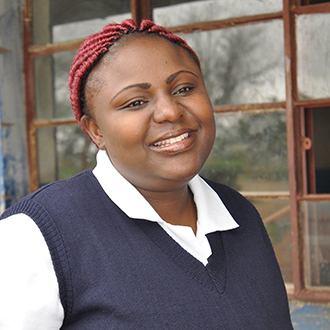With her hair tightly braided into cornrows and sporting a crisp white nurse’s gown and blue scrubs, Miriam Lussungo Bamba is a picture of competence. She needs to be both efficient and effective. Miriam is a midwife, nurse, administrator, counselor, and health champion for 15,000 people living in scattered communities within a 7-mile radius of Kafumbwe’s regional health center in eastern Zambia. And because she lives directly across from the facility, she is always on call.
Her waiting room – a concrete bench outside the facility that runs the length of the center –is overflowing with mothers and caregivers with young children, pregnant women, the elderly, and a few men. At the end of the queue, she greets a mother with a sick child. He is less than 1 year old and has a fever and chills. The young child had been “fitting,” the febrile convulsions that occur in young children when there is a rapid increase in body temperature. She directs the mother and child to a ward where a rapid diagnostic test (RDT) will check for parasites that cause malaria.
“The rapid diagnostic test is a very simple test,” Miriam said. “There is a device, a lancet, and a pipe. You prep the finger by wiping it with alcohol. Then you pipe the blood and dab the blood on the device, and you wait 15 minutes. One line is negative, and two lines are positive.”
The test is negative. The child has a viral illness or bacterial infection. Severe malaria can be hard to distinguish from other common childhood febrile illnesses including pneumonia, meningitis, and bacterial sepsis. Without diagnostics, caregivers may presumptively treat febrile illness as malaria. Therefore, the availability of high-quality, inexpensive RDTs has transformed the diagnosis and management of childhood illnesses in Zambia and across Africa, allowing for the rapid prescription of life-saving treatment, particularly for children.
In 2015, around half of children with a fever who sought care at a public health facility in 22 African countries, Zambia included, received a rapid diagnostic test for malaria, nearly double the number in 2010, according to the 2016 World Malaria Report.
Despite recent success against the disease, there were nearly 5 million reported cases in Zambia in 2015, and malaria is the number one cause of hospitalization. More than half of those killed by the disease are children under the age of five.
Miriam, also a mother of 3, almost lost her daughter, Tamani, to malaria 5 years ago. Now 10 years old, Tamani suffered from a bout of severe malaria. “It was really scary when my daughter got sick,” Miriam said. “I thought ‘is she going to die?’ She was very ill, vomiting and complaining of abdominal pain.” Tamani recovered, but the memory remains fresh for Miriam.
She noted that children still get sick from malaria but not to the extent previously seen. And now, precious few die. “I’m really grateful for the U.S. President’s Malaria Initiative because the burden of malaria has been lifted,” Miriam said. “Malaria used to kill a lot of people a lot of the time. A lot of deaths have been reduced.”
The Zambian Ministry of Health is investing in rural health centers and health posts and is working to increase the number of providers who make up frontline health teams. Nurses like Miriam who lead rural health facilities are absolutely essential to their local communities and to Zambia’s national health goals, including efforts to eliminate malaria. Miriam is hopeful about national efforts to end malaria in Zambia. “We have work to do, but I believe in Zambia and all Zambians.”

